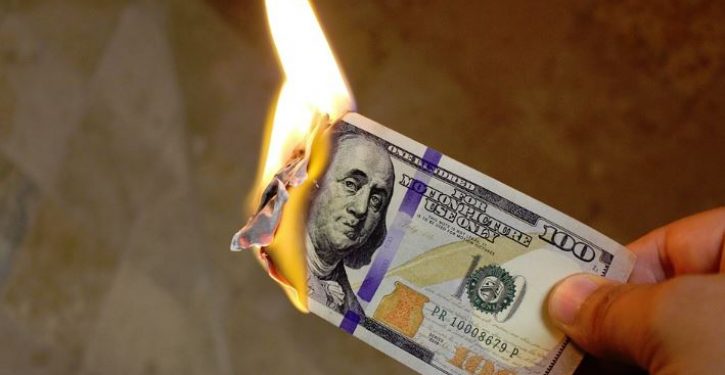
America’s national debt is equal to 127% of its economy, even if you accept the federal government’s deceptive accounting practices, which conceal a lot of debt and unfunded obligations. As interest rates rise, that national debt could inflict a world of pain on the economy, resulting in radically increased interest payments on the national debt. As George Mason University’s Bruce Yandle notes, “Inflation means interest rates could rise. Higher interest rates will make the national debt more expense. The Fed may soon get serious about hitting the monetary brakes to slow the economy”:
Recent comments from Federal Reserve Chair Jerome Powell hinted that the Fed may soon get serious about hitting the monetary brakes to slow the economy….Price levels likely will rise into 2022. The all-item consumer price index (CPI) was up more than 5 percent on a year-over-year basis for July, August, and September. The increase for October was 6.2 percent—the largest jump since 1990. The Fed considers 2 percent inflation to be its goal….The producer price index, a leading indicator of consumer prices, is up even more than the CPI. It shows an 8.6 percent year-over-year increase for September and October, the largest since the series started in 2010….U.S. inflation outpaces inflation in the eurozone and G-20 countries….The inflation rate is reflected in interest rates that borrowers must pay, especially for longer-term debt. Lenders hope to be paid back with at least as much purchasing power. If they believe inflation will tick away at 4 percent, interest rates will tend to rise. Higher interest rates mean higher interest costs on all forms of public and private debt. As a result, mortgage rates will rise, all forms of construction will suffer, and businesses will postpone making large investments in plants and equipment.
Now consider the public debt—especially the federal debt, which ballooned as a result of large budget deficits in recent years. (In 2020, the federal government raised $3.4 trillion in revenue and spent $6.6 trillion.) The interest cost of the national debt was $253 billion in 2008, equivalent to $325 billion in 2021 dollars; it remained around that level through 2015. Even though the debt doubled in those years, sharply falling interest rates and low inflation helped contain costs.
But that was yesterday. With today’s higher inflation and rising interest rates (perhaps with more to come), the Congressional Budget Office (CBO) estimates that the interest cost of public debt is $413 billion in 2021….Obviously, any dollar spent on interest cannot be spent on government benefits or services….For 2026, it projects that the interest rate on 10-year Treasury bonds, currently 1.5 percent, will be 2.6 percent, and that the interest cost of the federal debt will rise to $524 billion. For 2030, the projections are 2.8 percent and $829 billion [plus inflation]….To put $829 billion into perspective, in 2020 the United States spent $714 billion on the military, $769 billion on Medicare, and $914 billion on all nondefense discretionary spending, all stated in 2020 dollars….The United States is experiencing an inflationary surge caused fundamentally by the injection into the economy of trillions of dollars—stimulus and other spending—without an accompanying rise in production of goods and services that might be purchased with the new dollars. It’s rising demand plus troubled supply….As the process continues, our government—the source of inflation in the first place—will face hard choices when paying for past and future deficits and rising debt. And that, as they say, is when the rubber will hit the road.
“The existence of the debt saps the rest of the economy,” says the University of Pennsylvania’s Efraim Berkovich. “When the government is running budget deficits, the money that could have gone to productive investment is redirected. … [Y]ou’re taking away from the capital that we need to grow our economy in the future.”
This ocean of debt will expand further if Congress adopts additional spending proposed by Biden, such as his $2.3 trillion infrastructure plan. Biden’s infrastructure plan will spend big on obsolete technologies, and shrink private investment in infrastructure by $1 trillion. And although it will contain major tax increases, those tax increases won’t cover its massive costs. Biden’s infrastructure plan relies on funny accounting, covering spending for just 8 years with 15 years of tax increases. So in its first eight years, it will clearly add to the budget deficit, crowding out private investment and thus shrinking the economy.
The Biden administration “forecasts deficits at more than $1 trillion for at least the next decade” if his budget plan is adopted, noted CNN.



